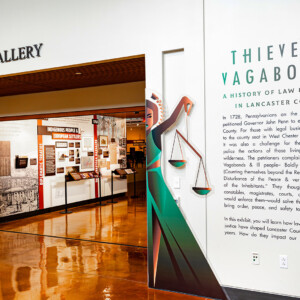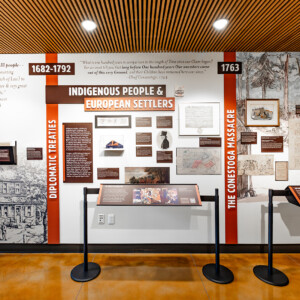Thieves & Vagabonds

LancasterHistory’s newest, major exhibition, Thieves & Vagabonds, chronicles key moments in the history of law and justice in Lancaster County from the 18th century to the 20th century. From prisons to prohibition, Thieves & Vagabonds explores the making, breaking, and remaking of laws over 300 years of Lancaster County’s history. Visit LancasterHistory’s newest exhibition for a deep dive into crime and punishment as well as reform and repair in the Lancaster community.
Topics discussed include the following…

- Key moments in the experience of early European settlers and the fraught relationship between them and Indigenous People, including the 1744 Treaty of Lancaster and the tragic massacre of the Conestoga Indians in 1763.
- The work of colonial-era lawyers and politicians to create new laws and regulations in a rapidly-changing American world before, during, and after the American Revolution.
- Pennsylvania’s role in addressing slavery, from the 1780 Act for the Gradual Abolition of Slavery to the regional response to the 1850 Fugitive Slave Act and the Christiana Resistance of 1851.
- An examination of how two Lancastrians—James Buchanan and Thaddeus Stevens—affected federal law and legislation during critical moments such as the Dred Scott decision, the Civil War, and Reconstruction.
- A thorough exploration of how the criminal justice system evolved in Pennsylvania and the United States through the lens of events in Lancaster County. Lancaster County was founded in 1729, in large measure to help citizens on the frontier manage issues of commerce and crime. Looking at the evolution of its courts and prisons over 300 years provides a strong representative example of the unfolding patterns of law and justice throughout the United States.
- The work of the Law and Order Society in the early 20th century to resolve moral dilemmas probed by society—issues such as “vice,” prostitution, and gambling—and how they affected social reforms.
- The evolution of the temperance movement and prohibition including the history of Lancaster County’s brewing industry and efforts to enforce and defy the 18th Amendment in the 1920s and 30s.
- Movements through the last 100 years to use the law and justice systems to increase the quality of life for all and uphold equal access to Civil Rights.
The exhibition will also ask the viewer to consider their perceptions of justice. Is it blind? Can it be truly impartial? LancasterHistory encourages visitors to think critically throughout their visit to the exhibition and consider these questions and what justice means to them.
Why “Thieves & Vagabonds?”
In 1728, a group of Pennsylvanians petitioned Governor Patrick Gordon to create a new county in the state’s western frontier. At the time, Chester County stretched all the way to the Susquehanna River, putting residents up to fifty miles from the county seat in West Chester. This meant long journeys for residents with legal business. It also meant that it was difficult for officials to police the actions of those living in the distant wilderness. The petitioners complained that “Thieves Vagabonds & Ill people– Boldly infest our parts (Counting themselves beyond the Reach of Law) to the Disturbance of the Peace & very great Damage of the Inhabitants.” The petitioners and the English government which granted their charter in 1729 thought laws–and the constables, magistrates, courts, and prisons who would enforce them–would bring peace, safety, and justice to their community. We took “Thieves” and “Vagabonds” from this complaint out of which Lancaster County was formed for the headline of our latest exhibition.
Exhibit Views



Interested in visiting the exhibition? Visitors can purchase General Admission or Museum Exhibition Only admission online.




